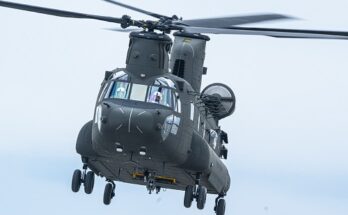The Indian government is ready to move forward with a procurement of 26 French-built Rafale combat aircraft. The selection of the Rafale M (Marine) variant to meet the Indian Navy’s requirement for new fighters to operate off its two carriers – the INS Vikrant and INS Vikramaditya – was announced on July 14, one day after the potential acquisition was cleared by the country’s Defence Acquisition Council (DAC).
L’Inde sélectionne le Rafale Marine https://t.co/iJb6Ux2Onj
India selects the Navy Rafale https://t.co/rxWTouCBEA#DassaultAviation pic.twitter.com/B3FqHxI4Cd— Dassault Aviation (@Dassault_OnAir) July 14, 2023
With the INS Vikramaditya currently operating the Russian-built MiG-29K from its deck, the question for the Indian Navy became what platform to acquire to complement the INS Vikrant, India’s first indigenous aircraft carrier. Though the INS Vikrant was commissioned on September 2, 2022, the ship is not expected to be ready for full operational service until early 2024 after MiG-29Ks complete a series of ongoing trials from her flight deck.
The Indian Navy has pushed for the acquisition of 57 multirole carrier-based fighters since January 2017. With the Vikrant still under construction at the time, the Indian government repeatedly pushed the program to the right, instead prioritizing other, more urgent requirements.
Rather than delay the process further by waiting for development of a navalized version of the Tejas Light Combat Aircraft, the LCA-Navy, by state-owned HAL, the Indian Ministry of Defence, together with the Indian Navy, opted for a foreign-sourced off-the-shelf solution – the so-called Multi-Role Carrier Borne Fighter (MRCBF).
The MRCBF was viewed as a capability bridge until a longer-term indigenous solution could emerge as a viable option.
The MRCBF contest came down to two platforms: Boeing’s F/A-18E/F Super Hornet and Dassault’s Rafale M.
Following trials of both types conducted in Goa in 2022, the Navy opted for the Rafale M.
But due to budgetary pressures, the service has had to settle for a smaller acquisition than outlined in its original requirement. Thus, the total number of fighters cleared by the DAC for procurement amount to less than half the 57 units originally outlined.
Meanwhile, the serviceability levels of the MiG-29K fleet have proven to be extremely low (a high of 37 percent of the single-seat MiG-29Ks and 47 percent of the two-seat MiG-29KUB variants), and five had crashed through 2022.
Therefore, with INS Vikrant nearing operational readiness and the current carrier-borne fighter fleet proving to be underwhelming in terms of serviceability and safety, the quick acquisition of the Rafale M is now paramount.
The model in this case is the previous Rafale procurement conducted on a government-to-government basis. This deal, signed in September 2016, involved 36 Rafales allocated to the Indian Air Force.
But simply because the DAC has cleared the acquisition of the Rafale M for the Indian Navy does not mean a contract signing is imminent. India’s defense procurement practices and processes are notoriously winding, byzantine and too often dysfunctional.
Despite being a government-to-government arrangement, even the earlier 36-unit Rafale procurement took a year from announcement to contract signature.
A similar path is highly likely.
To backfill any further carrier-borne fighter capacity needs for the Indian Navy, the locally designed Twin-Engine Deck-Based Fighter (TEDBF) will be considered. A model of this clean-sheet design (touted as a 4.5-generation fighter) was first displayed at Aero India in Bengaluru on February 3-5, 2021, and the preliminary design is expected to be submitted to the government for approval before the end of the year.
The TEDBF is being promoted as a successor to the MiG-29K and touted as a “Make in India” option for the Navy. However, the prototype for this fighter is not expected to undertake its first flight until 2026, with delivery of a serial production model unlikely to occur before 2031 in a best-case scenario.
In the meantime, the scale of the Rafale M acquisition may need to be widened to fill any emerging availability, serviceability, and capability issues in India’s carrier-borne fighter fleet.
India’s strategic planners harbor a goal of fielding three carrier battle groups – though preliminary approvals for the third ship are yet to be granted. Considering the length in time it will take to move from project approval to production to commissioning of this third carrier, the Indian Navy will have at least a decade in which to figure out its jet fighter capacity issues.
But when factored against the Indian MoD’s checkered history of defense projects, it becomes clear that planning for any combat aircraft acquisition should begin soon and procurement should run in parallel with that of the third carrier.
Dan Darling is Forecast International’s director of military and defense markets. In this role, Dan oversees a team of analysts tasked with covering everything from budgeting to weapons systems to defense electronics and military aerospace. Additionally, for over 17 years Dan has, at various times, authored the International Military Markets reports for Europe, Eurasia, the Middle East and the Asia-Pacific region.
Dan's work has been cited in Defense News, Real Clear Defense, Asian Military Review, Al Jazeera, and Financial Express, among others, and he has also contributed commentary to The Diplomat, The National Interest and World Politics Review. He has been quoted in Arabian Business, the Financial Times, Flight International, The New York Times, Bloomberg and National Defense Magazine.
In addition, Dan has made guest appearances on the online radio show Midrats and on The Media Line, as well as The Red Line Podcast, plus media appearances on France 24 and World Is One News (WION).



